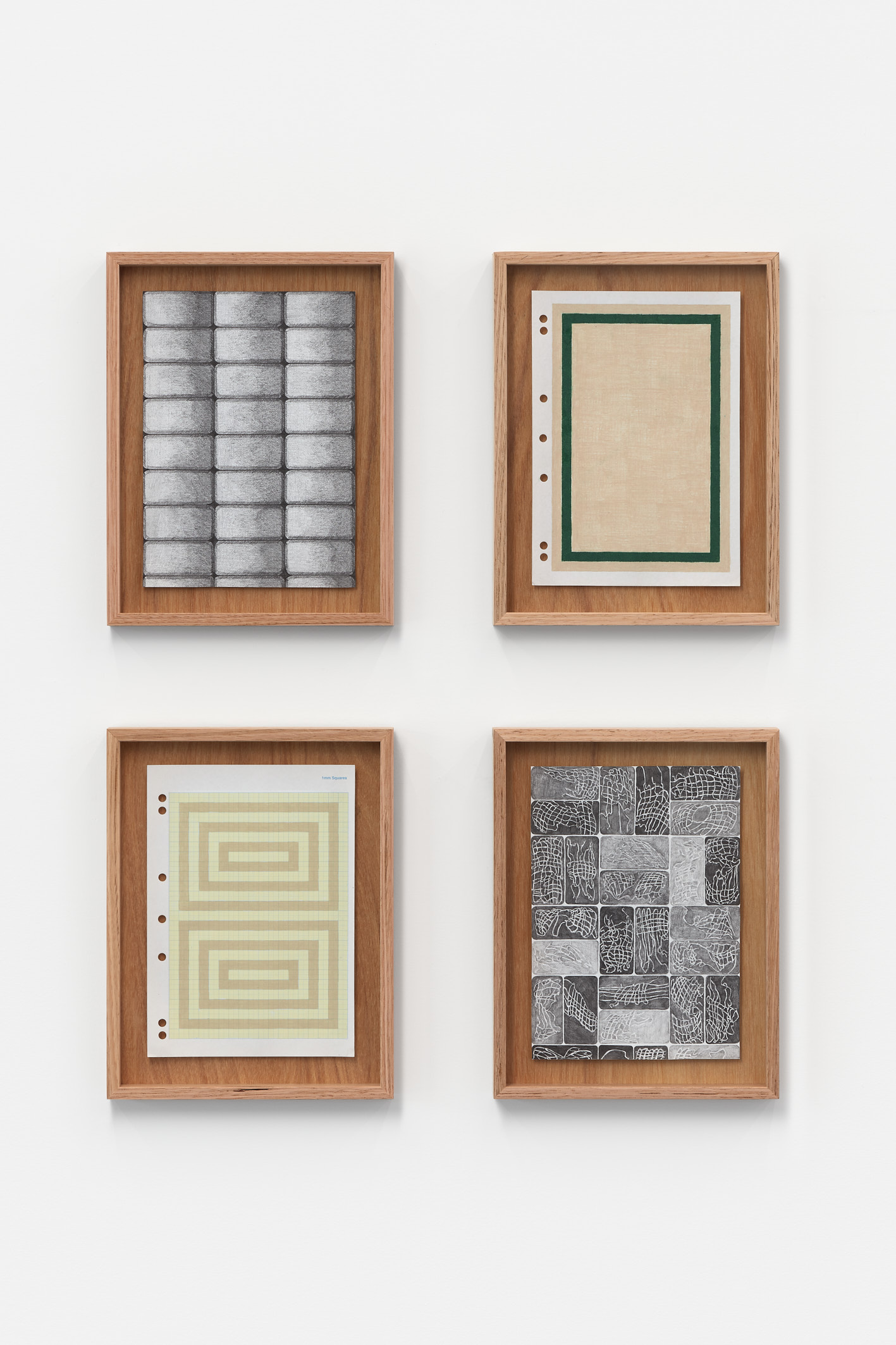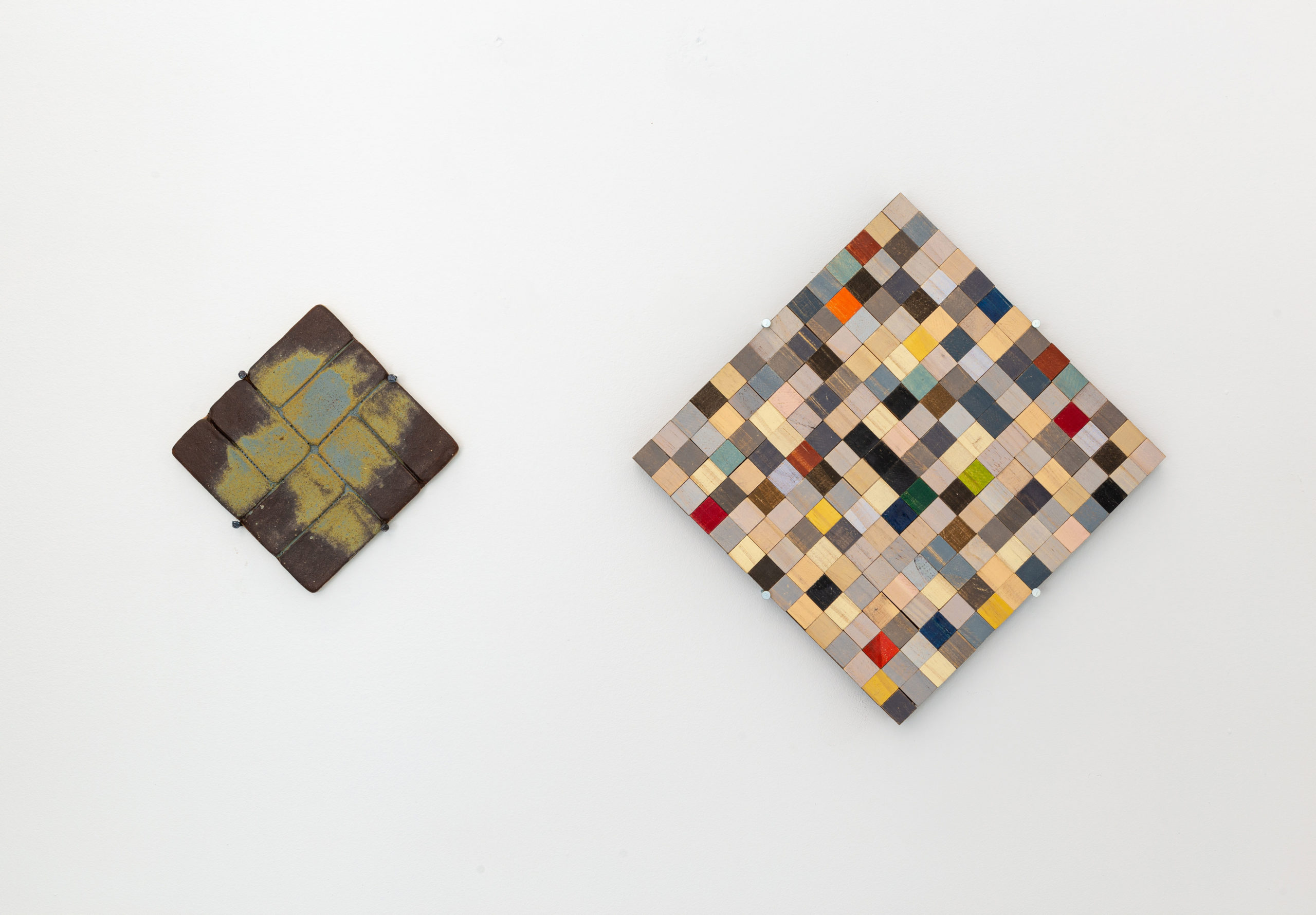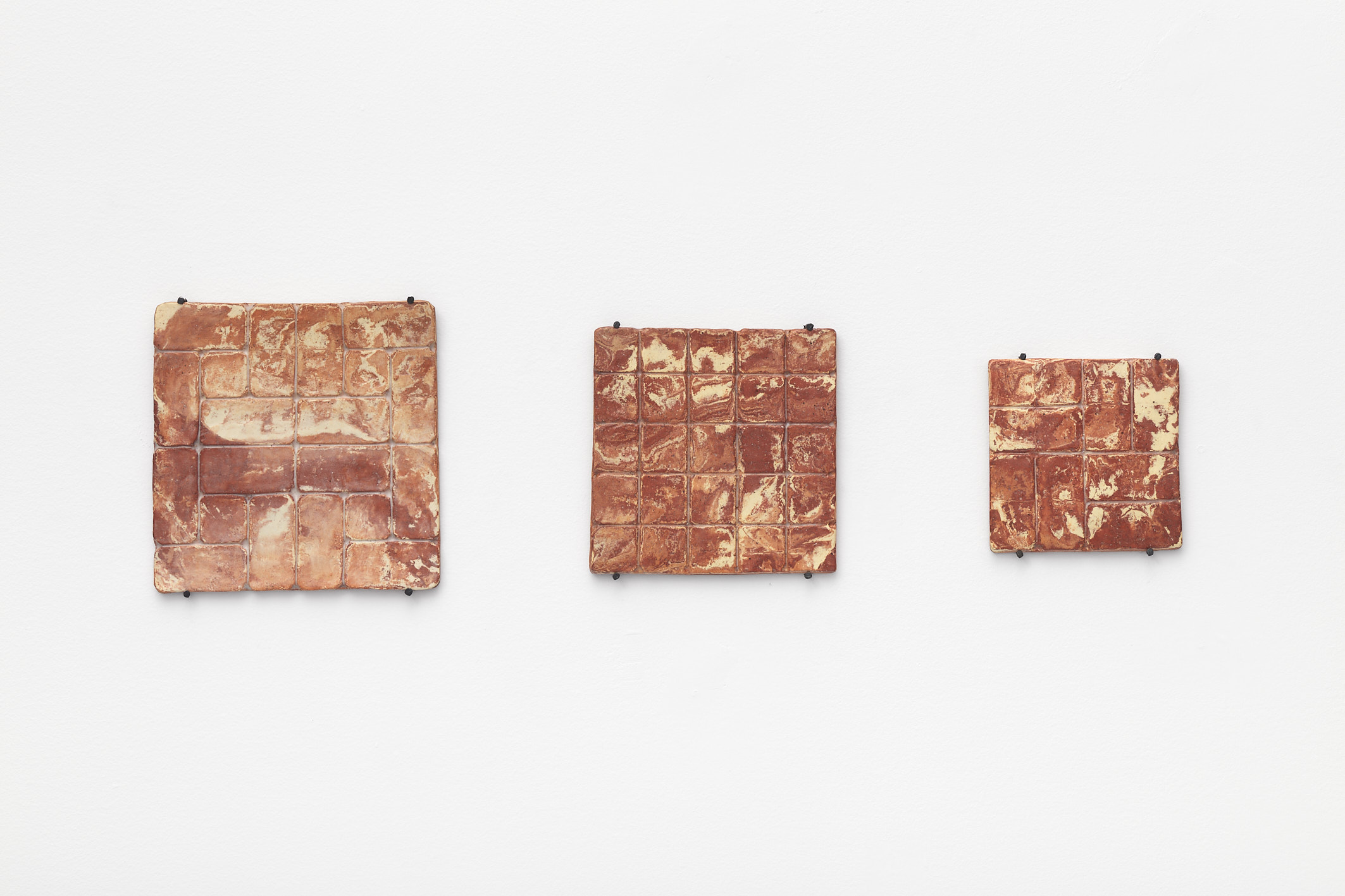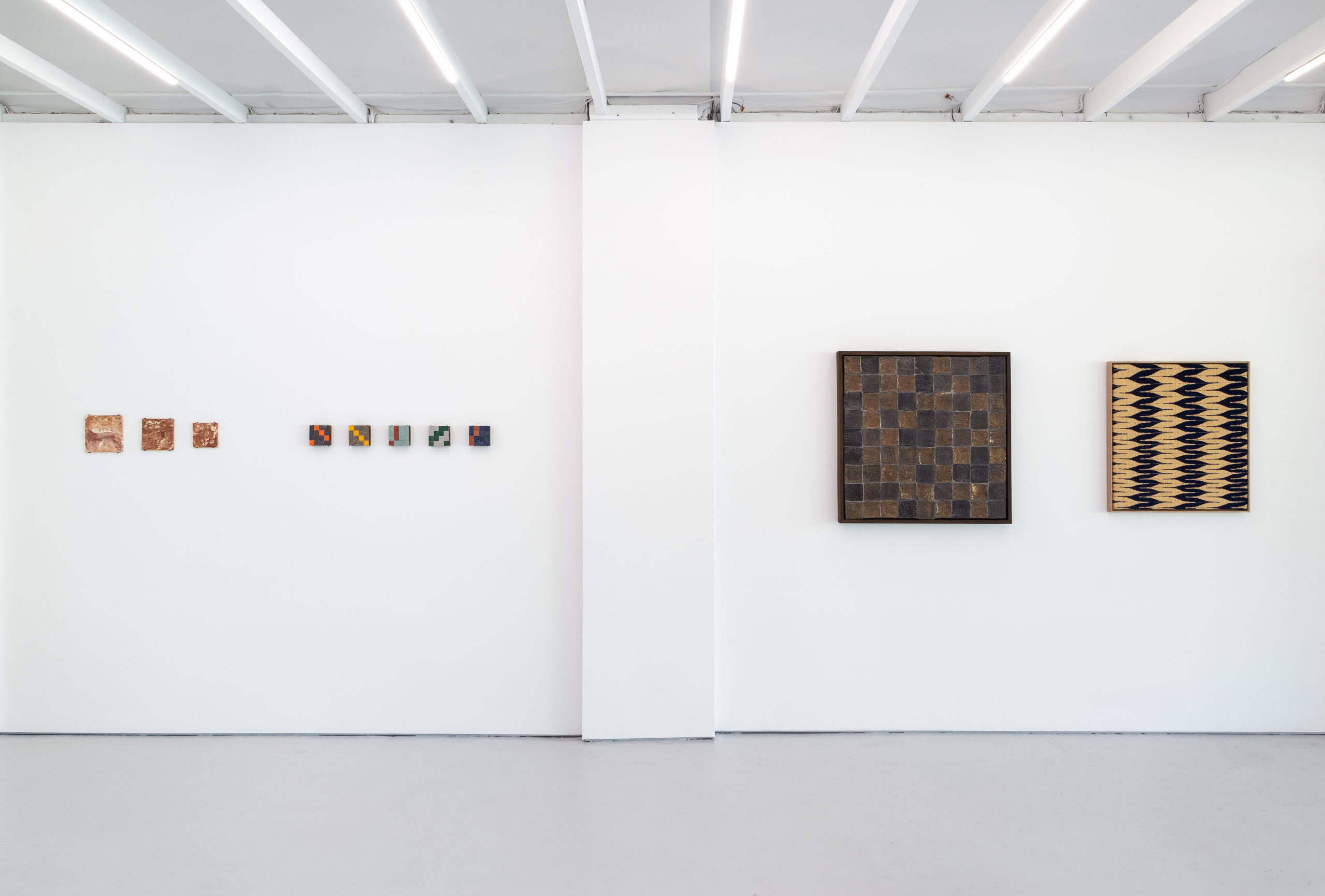A thread is used to mend or hold together—weaving itself in and out, in and out until it becomes intrinsic to a fabric and connects itself to a wider whole. The thread throughout this exhibition is the synergy of Jacqueline Stojanović and Jordan Mitchell-Fletcher’s friendship and collaboration; it is the magnetic force between them.
Jacqueline describes the movement of weaving as a “dance in form and colour.” This exhibition pirouettes poetically between the bright pops of colour in Jacqueline’s drawings and the deep navy and raw brown in her tapestry, which are paired with the polished and irregular textures of Jordan’s ceramic tiles, her intense terracotta marbling on earthenware and her shadowed graphite pencil drawings. Jacqueline and Jordan’s exhibition speaks to their own personal connection as friends and fellow artists, but also to broader traditions of craft and women’s work. Weaving and tiling are their respective primary mediums, ancient methods that intersect beauty with function. By continuing these traditions within their contemporary art practices, these two artists keep them alive, carrying them on. Driven by a strong work ethic, they are constantly teaching themselves new ways of making art and honing the skills of their mediums. Their collective inquiry into the form of the square and the diamond is explored through wood, wool and ceramic, all materials belonging to the Earth. This is harmonised with a focus on working with their hands and utilising tools—a loom, a kiln.
Jacqueline experiences weaving as both a social and solitary space. As a discipline, it has connected her to many people, notably weavers in the countries she calls home, both in Pirot, Serbia and in Langwarrin, Victoria. A master weaver of the McClelland Spinners and Weavers Guild gifted Jacqueline the table loom she works on now, one woman passing on knowledge and equipment to another. The wool she uses is sometimes gifted from a friend. But weaving also requires many hours alone, a pouring of energy, one to one, between artist and apparatus. An embodiment of that labour and time, the artworks then take on their own stories. Jacqueline has also begun to teach weaving, and the oral histories continue.
Seeing her practice as a study of processes, Jordan spends a long time with her ceramics, each piece carved by hand, fired once, glazed, and fired again. If she isn’t satisfied with the outcome, she breaks the objects down and reuses them—the cycle repeats. She sees her ceramics as existing within a ‘temporal arc’ and thinks about how “presentation is just a moment in the timeline of a work.” Interested in how a glaze can render different shapes and colours, this part of Jordan’s process is all by estimation, a trial and error, fingers crossed as the artworks come out of the kiln. Jordan’s larger tile relief Stack bond, 2021, is metallic and bronzed; from afar, it echoes an ornamental chessboard. Closer-up, you see the imprint of a textile element, a loose string weave, once malleable and free, now trapped and static within the darkness of the shiny tiles. The string is differently placed in every square, sometimes tightly together and sometimes spread wonkily apart, a soft abstraction that gestures in distinctive ways.
Both artists are interested in patterns they come across in books and the outside world. Jacqueline’s patterns are often pre-existing weaving patterns, but she is also deeply motivated by the intersection of geometric shapes and bold colours. Her works Twill 1, 2, 3 and Hopsack 1, 2 (2022) are coloured pencil drawn on small wooden blocks. Roughly made, they take on the character of a children’s game, worn over time and passed through many hands. Her varied use of either “twill” or “hopsack” weaving designs show the pattern from different aspects—from higher up, further away, or in double. Thinking about how over time, cultural patterns can lose meaning when their symbols are forgotten or out of context, Jacqueline questions how a once-ubiquitous pattern can be rendered abstract. The design for Trileće (2022), one of the artists’ larger weavings, originates from the Serbian style “three milk” cake, known for its feathered dual-toned decoration. To most viewers, it is simply an abstraction, but for Jacqueline, the textiles’ navy and honey-coloured wool warmly emulates the caramel and butter patterning, simple luxuries that melt in ones’ mouth.
Jordan often draws on details from her everyday life, such as the arrangement of tiles on a slippery floor at the swimming pool. Ever attentive to the brick patterns she sees on walks in her neighbourhood, she researches the pattern names before reconstructing them in her artworks. The brick-laying formation “Spanish bond” appears in one of her graphite drawings; meticulously drawn, the geometric markings appear uniform and faultless, but their tonal shading gives them a depth closer to reality. Jacqueline’s drawings are on 1mm grid paper pulled straight from the notepad; binder rings exposed. Allowing the grid to guide her abstractions, these works on paper are evocative of a weavers’ drafting process and speak to the immediacy of drawing as a medium. Linking both artists’ drawings is the laboured pencil marks, traces of touch which remind us of the nature and poetry of the home-made.
Throughout the exhibition, subtle links between the artists are everywhere in evidence, inherent between each work and proving friendship’s power of osmosis. While it is an interdisciplinary exhibition, all the artworks are underpinned by common ideas—of simplicity, repetition, beauty. They draw on their shared language, intuitively built by hand, both together and apart. The final two works in the exhibition are exemplary of this. Jacqueline’s playful and propulsive Colour Field Drawing (2022) takes on a distinctly tile-like quality evocative of a bespoke mosaic tabletop. Jordan’s Flat basket weave (2022) takes its shape from a weavers’ pattern and investigates how it translates to ceramic, the bleed and bleach of the glaze, creating a curious, organic finish. These two works appear on the edge of the space, heading into the gallery office and beyond. Tipped on its side, a square becomes a diamond, signaling a further playfulness to come.
—Emma Nixon, 2022
Emma Nixon is a curator and writer, curious about the tender intersections between art, life and friendships. She co-founded Cathedral Cabinet ARI in the Nicholas Building (2018) and completed her Honours in Fine Art (Curatorial Stream) at Monash University (2021). She is currently a Gallery Assistant at Monash University Museum of Art and Haydens.
Jordan Mitchell-Fletcher (b. 1993 in Melbourne, Australia) is a Melbourne based artist with a practice concerned with the conventions associated with craft, installation and basic sculptural principles. Playing with the tangent of making work and the residues that collate, her work is often repurposed as a way of considering sculpture as an ongoing process. Currently working predominantly with ceramic and mosaic, she explores a conglomerate of trials and tribulations, examining themes around femininity and the imperfection of the hand. Jordan completed a Bachelor of Fine Arts (Honours) at Monash University (2015). She has since exhibited in various solo and group shows both locally and internationally and was an artist in residence at AIRY, Yamanashi, Japan (2018).
Jacqueline Stojanović (b. 1992, in Melbourne, Australia) is a visual artist engaged with an expanded textile practice that considers histories of the handmade through the processes of weaving, drawing, and installation. Taking the position that weaving is an ancient carrier of culture, Jacqueline explores past and present personal cultural narratives; adopting the language of abstraction and approaching weaving through an open use of materials from the industrial to the domestic. She continues the practice of tapestry weaving within a contemporary framework, looking to the past as a means of navigating the present and challenging its rapid shifts in collective social and material values.
Jacqueline has exhibited across Australia and Europe, with works held in public and private collections, including The Justin Art House Museum, Melbourne and the National Gallery of Victoria Collection, Melbourne. She holds a Bachelor of Fine Art from Monash University (2014), and completed a Bachelor of Fine Art (Honours) at the Victorian College of the Arts (2015).
Jacqueline has conducted weaving workshops at the Workshop on Forster in Berlin (2018), the McClelland Sculpture Park+Gallery in Langwarrin (2020), and the Foundation House in Broadmeadows (2022). She was an artist in residence at The Icelandic Textile Centre in Blönduós, Iceland (2017).















